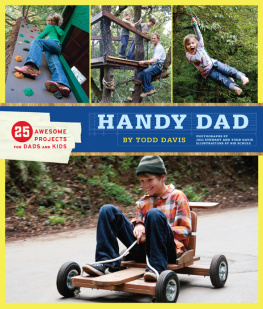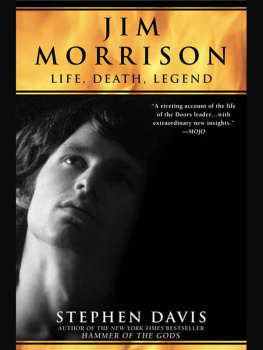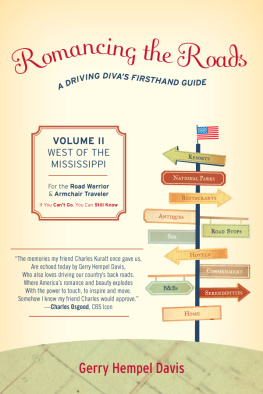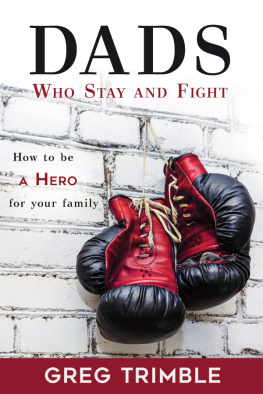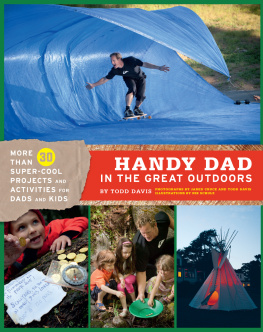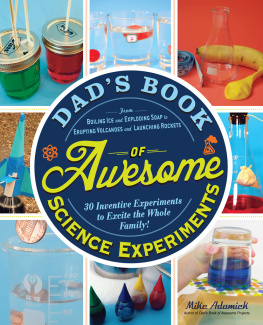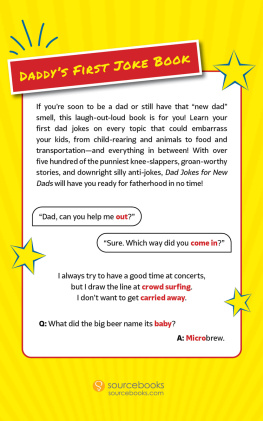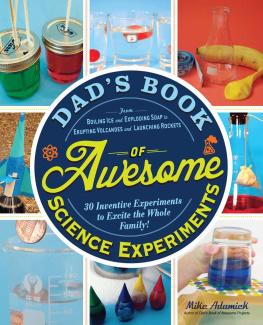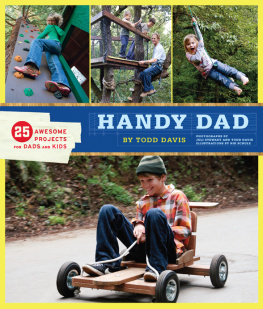This book is dedicated to my dad and my son.
W hen I was a kid, I had overwhelming urges to break things, real things: kitchenware, furniture, ceramic re-creations of Sweden, and virtually anything belonging to my sister.
My parents, however, were not willing to encourage this hobby of mine by providing me with any of their own possessions. Determined to teach me the value of material things beyond that of tinder, my father had the clever idea of getting me to build my own toys. In having me go through the process of designing and building airplanes and go-carts and child-sized medieval catapults, I suppose he thought I might come to respect property (other peoples and my own), thereby mitigating my sisters trauma in finding bald, one-legged Barbie dolls treading water in the toilet. He was right, at least partially.
I continued to destroy things, even those things my father and I made together, but I did so a bit more gradually. Since I hate having to repair anything, I began to build toys that would last. At the time, I did not grasp that my father was doing more than teaching me how to swing a hammer gracefully while inflicting the fewest number of injuries. In providing me with the space to create, he was teaching me how to see the world differently, how to plan for it, how to make beautiful and occasionally identifiable sketches, and, most important, how to use my imagination toward something that would keep me entertained long enough for my father to take naps.
Over time, my projects with my father took a more sophisticated turn. We built a birdcage to house the pigeons my friends and I caught while exploring a large creek next to the highway; it had a spring-loaded door. Another was a half-pipe with sheet metal spot-welded to the frame. My father continued to give me important advice on my projects even when I was confident enough to build things on my own. I didnt mindI enjoyed having him around correcting my technique, reminding me not to use his new drill, and calling out the distance between my hand and the serrated teeth of the chop saw.
Designing and building have been invaluable in my life. My childhood experiences led me to pursue a degree in landscape architecture, a career I decided to put on hold after graduation in order to compete in extreme snowboard and skiing competitions. In the years after college, I lived in a snow cave (my own design) in Argentina for one month; broke some records in extreme sports such as skydiving, skiing, snowboarding, mountain biking (downhill), surfing, waterskiing, high diving, and skateboarding; and threw myself off cliffs and buildings for money in movies and commercials. I was the runner-up in HGTVs Design Star competition and began hosting a show about home improvements called Over Your Head, also on HGTV. I currently run a successful design company called Epic Spaces. The companys principal focus is on creating dynamic, interactive spaces for both outdoor and indoor environments.
When I build, I do so in direct response to other peoples work, with the intent of improving upon it. I also always build things for my own use first, which means they must be able to withstand frequent and prolonged physical abuse. Though I sometimes build feverishly, I have come to temper my sense of urgency to bring a project to completion. Making a toy by hand is a lesson in problem solving, and I have learned to cherish those moments with family and friends when we can look critically at a project and make slight changes for the purpose of improving it. Sometimes the suggestions of ones family and friends are not very helpfullike, Why dont you call your go-cart Superfast Stuff?but often they can open the proverbial doors of perception and actually teach you something about being a handy dad.
The projects in this book also have been designed for both indoor and outdoor activities and for both dads and kids to make and enjoy. It is enough to choose an activity that your child is relatively passionate about and then begin experimenting and building together. I do not expect every child who makes a dollhouse from this book to become the next Frank Gehry, but I am confident these projects will stimulate childrens creativity and encourage their pursuit of bliss, as well as give fathers something to do with their kids that does not involve computer games or listening to Raffi.
These projects are inspired by the things I liked to do as a kid, things my dad taught me about building, and the risk-taking and extreme sports Ive done as an adult. Youll find step-by-step instructions for making a whole range of stuff. Whip up a sweet half-pipe or BMX ramp for the little adventurers in your life; take some time building a tree house, zip line, climbing wall, or tire swing in the backyard to keep your kids and their friends entertained for years on end; spend some quality time indoors building angel wings or a dollhouse that will bring a smile to any little girls face; throw together a pressurized water rocket, water-balloon launcher, slip-and-slide, or tie-dye station for an afternoon of guaranteed fun. Trust me, the process of building these things with your kids is almost as fun as watching the delight on their faces when they see the finished product.
Fittingly, my wife and I just had a baby boy. He is already beginning to understand how stacking colored blocks into sophisticated little piles can improve his world. Having been taught so many wonderful things by my own father, I cannot wait to encourage my sons growth. I am looking forward to the moment when things go wrong, so I can spend that much more time with him, watching him as he tries to figure out how to make side lashings for his first rope bridge out of lint and dental floss. I know that soon enough he will be fixing the carburetor on his fathers car, leaving me behind with my own handy dad as we struggle to fix his recliner.
EASY
PROJECTS
When you reminisce about the days of bell-bottoms, Bee Gees, and moonlight skates at the roller rink, do your kids just stare at you blankly? Well, the 70s might not mean much to them, but I bet theyll freak out when they see this mind-blowing icon of awesomeness. All you need to make a totally trippy lava lamp is some oil, water, food coloring, and a little Alka-Seltzer. Plop, plop, fizz, fizz, oh how far-out it is!
DIFFICULTY LEVEL:
Super-easy
TIME INVOLVED:
30 minutes
MATERIALS:
One 4-foot 1x6 redwood board (you can substitute cedar or pine)
IKEA Dinge lamp (cost: about $3) plus 25-watt light bulb
20 ounces vegetable oil
6 ounces water
Food coloring
26-ounce pasta-sauce jar
Alka-Seltzer tablet
FASTENERS:
11/4-inch wood screws (14)
TOOLS:
Drill with Phillips-head bit, 1/8-inch bit, and 21/4 -inch hole-saw attachment
Jigsaw with a multipurpose blade
Circular saw or chop saw
Ruler
Pencil
Two mini bar-clamps

INSTRUCTIONS:
From the 16 board, cut two pieces that each measure 41/4 5 inches. These will be the A SIDEWALLS . Label them, if it will help you keep track. Remember that your saw blade will use up 1/8 inch of material as it cuts. Measure carefully.
Cut two more pieces that each measure 23/4 5 inches. These will be the B SIDEWALLS .
Cut a small notch out of a corner of one of the B SIDEWALLS to accommodate the lamps power cord.

